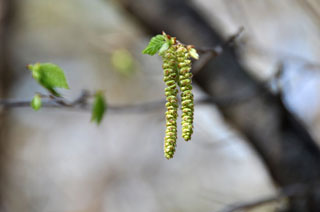IRONWOOD
|
 |
| File Size: 37 KB |
|
|
|
Ostrya virginiana (P. Mill. ) K. Koch
|
| Johnson County, Kansas |
| Height: 12-32 feet |
| Family: Betulaceae - Birch Family |
| Flowering Period: April, May |
|
| Also Called: | | Hop hornbeam. | | Trunks: | | Short; diameter 8 to 12 inches; crown open, broad, rounded or narrow; branches long, slender, spreading; bark thin, reddish-brown to grayish-brown; furrows shallow; ridges narrow, plate-like, sometimes with shaggy appearance. | | Twigs: | | Slender, flexible, slightly zigzag, pubescent near tip, initially green, becoming reddish-brown to dark brown; leaf scars 2-ranked, small, crescent-shaped or half-round; bundle scars 3; buds sessile, egg-shaped, 1/8 to 1/4 inch long, pointed; scales 5-7, arranged spirally, reddish-brown. | | Leaves: | | Alternate, simple, deciduous; narrowly egg-shaped to elliptic, 2 to 4.8 inches long, 1.2 to 2.4 inches wide; upper surface dark green, dull, glabrous or sparsely pubescent; lower surface paler, pubescent, more so on veins; lateral veins 10-16 on each side of midrib; margins unevenly double-toothed; tip pointed to tapering-pointed; base shallowly heart-shaped to tapering or rounded; stalk slender, 1/6 to 2/5 inch long, pubescent. | | Flowers: | | With the leaves; monoecious (male and female flowers on same tree); staminate catkins form in the previous season, usually in 3's, drooping, cylindric, 4/5 to 2 inches long, reddish-brown; elongating at flowering; flowers crowded; catkin scales cupped, green with outer margin brown, short-pointed; stamens 3-7+; anthers yellow; pistillate catkins solitary or usually in pairs, erect or nodding, slender, 1/2 to 1 inch long, few flowered; each flower enclosed 2 white, woolly bracts with margins united, resembling sac; style and stigma thread-like; stalk 1/2 to 3.4 inch long; | | Fruit: | | July-September; nutlets, 10-25, arranged in cone-like cluster, 1.4 to 2.6 inches long, 4/5 to 1 inch wide, 4/5 inch thick; each nutlet egg-shaped to elliptic, 1/5 to 1/3 inch long, flat, olive-brown, shiny, enclosed in 2 bracts; bracts egg-shaped, 1/2 to 1 inch long, papery, veined, tan or straw-colored; tips tapering-pointed; stalk to 4/5 inch long. | | Habitat: | | Woods on well-drained slopes and ridges, beneath taller trees, borders of moist to dry upland woods, rarely stream banks and flood plains; often on rocky soils. | | Distribution: | | East 1/3 of Kansas | | Origin: | | Native | | Uses: | | Native Americans steeped the bark and used the liquid as a wash for sore muscles and held it in the mouth to treat toothaches. A decoction of wood was taken for coughs and kidney disorders. The flowers were used in face-painting. The wood was used to make bows, tool handles, and as building material for dwellings. | | Comments: | | The common name hop hornbeam alludes to the fruits, which resemble clusters of hops. Ironwood grows very slowly. The wood is heavy, very strong and hard, durable, pale reddish-brown, with a thick, white sapwood. It is one of the hardest woods found in Kansas, which the common name ironwood alludes to. |
|
| Ironwood staminate catkins |  | | 37 KB | | Johnson County, Kansas |
| | Ironwood staminate catkins |  | | 119 KB | | Johnson County, Kansas |
| | Ironwood bark |  | | 78 KB | | Johnson County, Kansas |
| | Ironwood leaf |  | | 57 KB | | Wildcat Glades Conservation & Audubon Center, Newton County, Missouri |
| | Ironwood leaves |  | | 102 KB | | Wildcat Glades Conservation & Audubon Center, Newton County, Missouri |
| | Ironwood fruit |  | | 90 KB | | Wildcat Glades Conservation & Audubon Center, Newton County, Missouri |
| | Ironwood fruit |  | | 57 KB | | Wildcat Glades Conservation & Audubon Center, Newton County, Missouri |
| | Ironwood fruit |  | | 94 KB | | Douglas County, Kansas |
| | Ironwood bark |  | | 70 KB | | Wildcat Glades Conservation & Audubon Center, Newton County, Missouri |
| |
|
|
|











